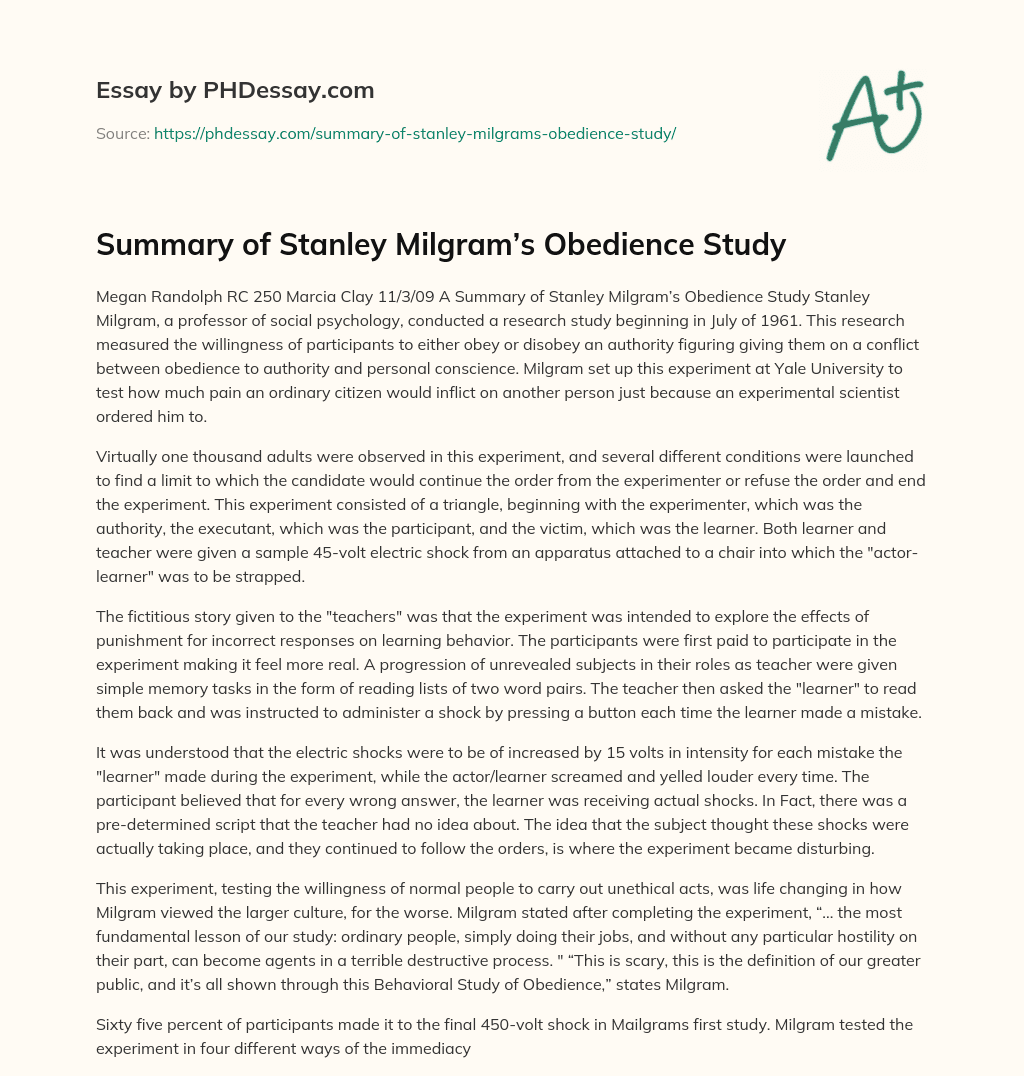Review of Stanley Milgrams Experiments on Obedience Summary
Megan Randolph RC 250 Marcia Dirt 11/iii/09 A Summary of Stanley Milgram'due south Obedience Report Stanley Milgram, a professor of social psychology, conducted a research study beginning in July of 1961. This research measured the willingness of participants to either obey or disobey an authority figuring giving them on a conflict between obedience to authority and personal conscience. Milgram set this experiment at Yale Academy to test how much pain an ordinary citizen would inflict on another person just because an experimental scientist ordered him to.
Virtually 1 yard adults were observed in this experiment, and several different conditions were launched to discover a limit to which the candidate would continue the club from the experimenter or reject the club and end the experiment. This experiment consisted of a triangle, beginning with the experimenter, which was the authority, the executant, which was the participant, and the victim, which was the learner. Both learner and teacher were given a sample 45-volt electric stupor from an apparatus attached to a chair into which the "player-learner" was to be strapped.
The fictitious story given to the "teachers" was that the experiment was intended to explore the effects of punishment for wrong responses on learning behavior. The participants were beginning paid to participate in the experiment making it feel more existent. A progression of unrevealed subjects in their roles every bit teacher were given unproblematic retention tasks in the form of reading lists of ii word pairs. The teacher then asked the "learner" to read them dorsum and was instructed to administer a shock by pressing a button each time the learner made a mistake.
Guild custom essay Summary of Stanley Milgram'south Obedience Report with gratuitous plagiarism written report
Get ORIGINAL Newspaper
It was understood that the electrical shocks were to be of increased by fifteen volts in intensity for each error the "learner" made during the experiment, while the histrion/learner screamed and yelled louder every fourth dimension. The participant believed that for every wrong reply, the learner was receiving actual shocks. In Fact, there was a pre-determined script that the instructor had no thought nearly. The thought that the subject idea these shocks were actually taking place, and they continued to follow the orders, is where the experiment became disturbing.
This experiment, testing the willingness of normal people to carry out unethical acts, was life irresolute in how Milgram viewed the larger culture, for the worse. Milgram stated after completing the experiment, "... the near primal lesson of our study: ordinary people, merely doing their jobs, and without any detail hostility on their part, can become agents in a terrible destructive procedure. " "This is scary, this is the definition of our greater public, and it's all shown through this Behavioral Study of Obedience," states Milgram.
Sixty five percent of participants made it to the final 450-volt stupor in Mailgrams commencement study. Milgram tested the experiment in four dissimilar ways of the immediacy of the victim. Offset with the start status, the victim was placed in another room and could not be seen or heard past the participant, just pounding on the wall when volts reached over 300. This condition was titled remote feedback, and was revealed to be easier for the participant to continue the experiment without remorse.
The second condition is where the voice protests were commenced and the teacher could hear the victim's complaints titled voice feedback. Although they could hear the learner, the victims were all the same easily put out of mind considering they could not exist seen. The 3rd experimental condition, Milgram placed the victim in the aforementioned room as the participant, being both visible and audible, the proximity. When the victim was shut it was more difficult to exclude him, making it more difficult for the participants to obey the experimenter.
Lastly, the fourth condition was the touch proximity, where the victim received a shock only when his hand rested on the shock plate. When the victim would refused to place his manus on the plate, the experimenter would order the participant to come in physical contact with the victim and forcefulness his hand onto the plate. " The Machinery of denial tin no longer exist brought into play" in the proximity weather. Information technology'southward non as like shooting fish in a barrel to harm a person when you can visually run across the pain i is inflicting. Forty adult subjects were studies in each condition.
The data revealed "that obedience was significantly reduced as the victim was rendered more immediate to the discipline". According to Stanley Milgram'due south study Some Weather condition of Obedience and Defiance to Potency, there are many dissimilar factors they may affect the end event of a subjects obedience to a dominating figure. These factors include, the immediacy of the victim, closeness of say-so, tensions, and groundwork authority. The locality of each situation showed differences in the responses of the participant and their willingness to obey or disobey the experimenter.

Did you know that we have over lxx,000 essays on 3,000 topics in our database?
Cite this page
Explore how the human trunk functions equally one unit of measurement in harmony in social club to life
Source: https://phdessay.com/summary-of-stanley-milgrams-obedience-study/
0 Response to "Review of Stanley Milgrams Experiments on Obedience Summary"
Post a Comment